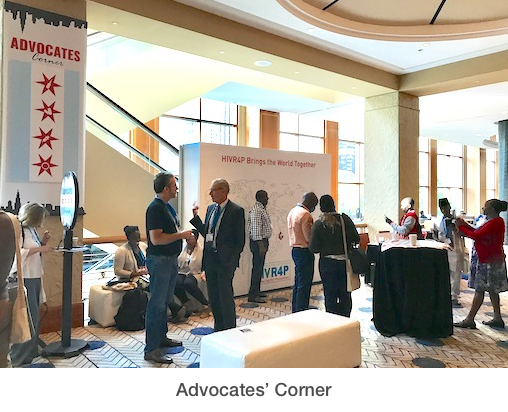October 17, 2016
Happy Monday and welcome to the first of AVAC’s updates from and about HIVR4P, the biennial conference on all things biomedical prevention. As conference goers are already discovering, this gathering of advocates, researchers, clinicians, journalists and more is taking place in a city—Chicago—that’s gripped with baseball fever. The Chicago Cubs are in the midst of playoffs for the World Series. Looking for a conversation starter with a native Chicagoan? Try “How about them Cubs?” Looking for a guide to on what may spark conference fever—read on!
It takes guts! Unpacking the latest news in “cure” research
R4P features a plenary talk by Dr. Anthony Fauci, head of the US National Institutes of Allergy and Infectious Diseases, on a recently published paper that is the latest spark of hope in the field of cure research. This speech could trigger more US and European coverage of a story that has already gotten a fair amount of coverage in the past week. And it could help spread the buzz to sub-Saharan Africa and beyond, given the strong presence of international journalists at the conference. Here’s a quick walk through what people at R4P are likely to hear about these new data and what it might mean for advocates.
What’s the news?
The paper, published by a team out of Emory, reported on intriguing results from an experiment exploring HIV remission (also known as virologic suppression) in monkeys. The results have been explained fully and very clearly in this aidsmap article and by veteran science writer Jon Cohen. Very briefly, the study design involved infecting monkeys with the simian form of HIV (SIV). All of the monkeys were subsequently put on antiretroviral treatment (ART) which controlled their virus. Some monkeys were also dosed with a simian version of an antibody, known as vedolizumab. In human form, this antibody helps treat inflammatory conditions of the gut, such as Crohn’s disease and ulcerative colitis. Others monkeys received a placebo. All the monkeys stopped ART after 90 days. The antibody group stopped the additional treatment after 23 weeks.
Eight of the 11 monkeys in the antibody group sustained virologic control, showed evidence of immune system replenishment, and remained off treatment for almost two years. In other words, they were able to keep SIV replication below the limits of detection—and saw the recovery of immune cells in the gut tissue that had been attacked by HIV. ART alone can control the virus but does not lead to immune reconstitution in the gut—one of the regions of the body where HIV first establishes infection. This type of virologic control means that the virus is likely still present in the body but at levels under the limit of detection (50 copies/mL).
What does it mean?
Monkeys aren’t humans and SIV isn’t HIV. This is a mantra of HIV research and it bears repeating in this case. What’s seen in non-human primates doesn’t necessarily predict what will happen in humans. However, this is the first time this kind of result has been seen in non-human primates—so that’s an exciting development. It is an animal model “proof-of-concept” that gives researchers something to build on. One area for exploration is understanding why the regimen had the beneficial effects that it did. This involves unpacking the immune responses observed in the animals.
One important finding: some of the monkeys had brief peaks of detectable virus before their immune systems were back up to speed, called a viral “blip”. This is a critical piece of information for clinical trial design. Protocols involving treatment interruption will have to determine how quickly to put a participant back on treatment if a rebound occurs. It is also unclear what, if any, role early treatment played in the eight monkeys’ remission. Early treatment has been shown to reduce the overall size of an HIV reservoir, the collection of non-replicating cells that harbor HIV in the body.
As noteworthy as the results might be, it’s important to remember that the Mississippi Child was in remission for 28 months before viral rebound occurred. The questions raised by these new findings have implications beyond cure as well. Understanding why these study results can also help in the search for an effective HIV vaccine. Since the drug involved in this experiment is already in use in humans for other conditions follow-up can happen fairly quickly. And it is: a small study is underway in people living with HIV.
Advocates should be cautiously optimistic about results and ready with the facts. Remission implies the virus and can return, and a public eager to see HIV solved need to understand there’s a long road ahead.
To learn more about HIV cure research visit CUREiculum, TAG media monitor and the research database.

Stay tuned for additional coverage of the latest from the conference and follow in real-time on Twitter. And each day we will preview the sessions planned for the Advocates’ Corner, a dynamic space to exchange ideas, build solidarity, network, relax and socialize. The full schedule is available here, and tomorrow’s sessions include:
- 10:00 – 10:30: Innovative prevention for women’s health: The promise of MPTs
- 12:00 – 1:00: HPTN 083: Long-Acting Injectable PrEP HIV Prevention Trial for Transgender Women and Cisgender MSM in 8 Countries
- 2:30 – 3:30: Moving Women’s Prevention out of the Siloes: A Discussion of Advocacy for PrEP and Female Condoms
- 5:00 – 6:00: Launch of the PrEP in Europe report
Stay tuned for more tomorrow!